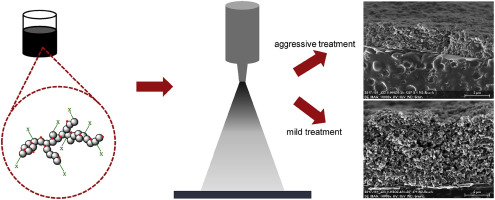Journal of Power Sources ( IF 9.2 ) Pub Date : 2018-09-12 , DOI: 10.1016/j.jpowsour.2018.09.005 Michael Bredol , Aleksandra Szydło , Ivan Radev , Wladimir Philippi , Roland Bartholomäus , Volker Peinecke , Angelika Heinzel

|
Polymer electrolyte membrane fuel cells (PEMFCs) operating at low temperature (60–80 °C, up to 110 °C) are mostly limited in their performance by the kinetics of the oxygen reduction reaction (ORR), leading to high loadings of platinum (Pt) in the cathode. Pt catalysts are without alternative in numerous industrial applications, and since Pt resources are limited, the associated high costs for low temperature fuel cells are hindering among other factors their commercialization. In order to increase the fraction of electrocatalytically available Pt towards ORR, this work is devoted to the factors responsible for the microstructure of the PEMFC cathodes. Typically, the active layers are coated by processes like spraying, doctor blading, printing etc. Therefore, the final structure actually is strongly dependent on the coating process and the physicochemical properties of the catalyst dispersions used. Selecting commercially available electrocatalysts from Johnson-Matthey and Tanaka as active material and ultrasonically assisted spraying as the coating method, systematic variations of the surface chemistry of the catalyst particles and their influence on catalyst layer morphology and therefore electrical and electrochemical properties of resulting membrane electrode assemblies (MEA) have been investigated. It could be shown, that the colloid–chemical properties of the catalyst dispersions have a profound influence not only on the microstructure of the MEAs but also on the performance under operating conditions.
中文翻译:

前体电催化剂分散体的胶体化学与聚合物电解质膜燃料电池性能如何相关
在低温(60–80°C,最高110°C)下运行的聚合物电解质膜燃料电池(PEMFC)的性能主要受到氧还原反应(ORR)动力学的限制,从而导致铂的高负载量( Pt)在阴极。在许多工业应用中,铂催化剂是无可替代的,并且由于铂资源有限,因此低温燃料电池的相关高成本阻碍了它们商业化的其他因素。为了增加对ORR的电催化可用Pt的比例,这项工作致力于影响PEMFC阴极微观结构的因素。通常,活性层是通过喷涂,刮刀刮涂,印刷等工艺涂覆的。因此,最终结构实际上很大程度上取决于涂布过程和所用催化剂分散体的物理化学性质。从中选择市售的电催化剂约翰逊·马修(Johnson-Matthey)和田中(Tanaka)作为活性材料,超声辅助喷涂作为涂覆方法,催化剂颗粒表面化学性质的系统变化及其对催化剂层形态的影响,因此也影响了所得膜电极组件(MEA)的电和电化学性能调查。可以看出,催化剂分散体的胶体化学性质不仅对MEA的微观结构有深远影响,而且对操作条件下的性能也有深远的影响。



























 京公网安备 11010802027423号
京公网安备 11010802027423号